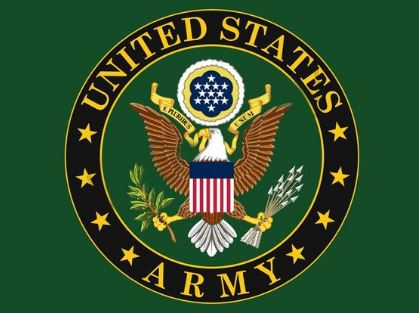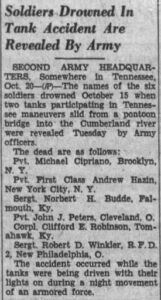Andrew Hazin

drowning

Accident: tanks slid into river while maneuvering at night without light (enforcement of “blackout” conditions at night was a common security tactic during WW2 to avoid possible enemy detection from overhead)
The following account of events is from a 2 November 1942 TIME Magazine entry:
“All day the Army engineers, interrupted by enemy fire, had labored to lay rubber pontoons, then wood crosspieces, finally steel tracks just wide enough for the 28-ton General Grants. At dusk the light tanks had crept out of the woods and skipped across the oily Cumberland River on the new pontoon bridge. When the mediums came down to cross, puncturing the dark with their exhaust flashes and red signal lights, the shore was lighted for safety’s sake, making a 200-yard circle of yellow dust-fog through which turrets poked, each with its pygmy man on top.
The first tank crossed the bridge. Out of the second crawled a tall young lieutenant. He walked ahead to lead it across. A little behind came a sergeant leading a third tank. They moved out on the flexible bridge.
Some ten yards from the bank the left tread of the rear tank climbed out of the treadway. The tank teetered for a fraction of a second, then the pontoons shifted. With treads still grinding and motor roaring, the tank plunged off the submerging treadway into the river, sank in a swirl of bubbling water. Almost on top of it plunged the tank ahead, down into the river out of sight.
“My God, the bridge has busted!” came the sharp cry of a young soldier.
They pulled a gasping tanker from the spot where the bubbles boiled up, and another, and another with a broken arm. The lieutenant who had been leading his tank was safe, clinging to the bridge, wet to the waist, but the sergeant had been crushed between the two tanks.
First rescued man ashore, his dark hair plastered wetly on his head, his dark eyes wild with excitement, was a 22-year-old tank driver who could not explain how he got out. “It musta been through the top somehow. . . . Did they get the others out?”
A small, dark, bright-eyed soldier from the other tank’s turret was almost hysterical. He spoke through chattering teeth: “Did the others get out? Oh, Jesus, I hope they get them.”
There was nothing to do. The tanks were buttoned up for combat.
The engineers began pulling out the twisted bridge section while the tank company held a roll call in the cornfield. Six men were missing. Said a hard-as-steel, greasy young man leaning against his tank: “They was good guys.”
Last week came new bridge-crossing orders for tankers: only the driver will ride in the tank, stripped of equipment and ready to jump”
U.S. Army: undisclosed location in TN, drafted May 1941
Findagrave profile: https://www.findagrave.com/memorial/2646437/andrew-hazin

